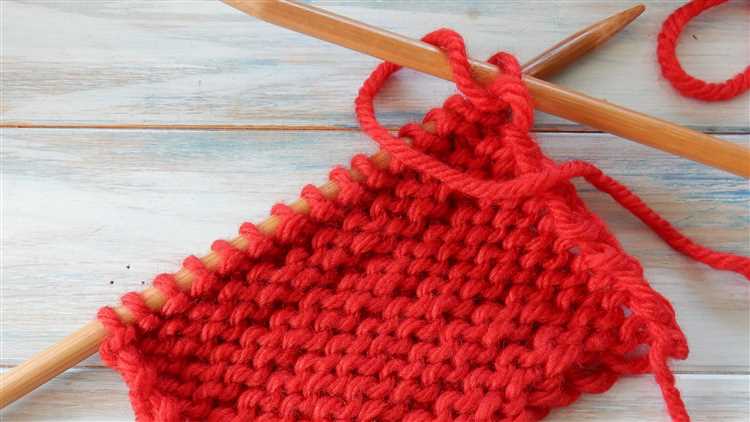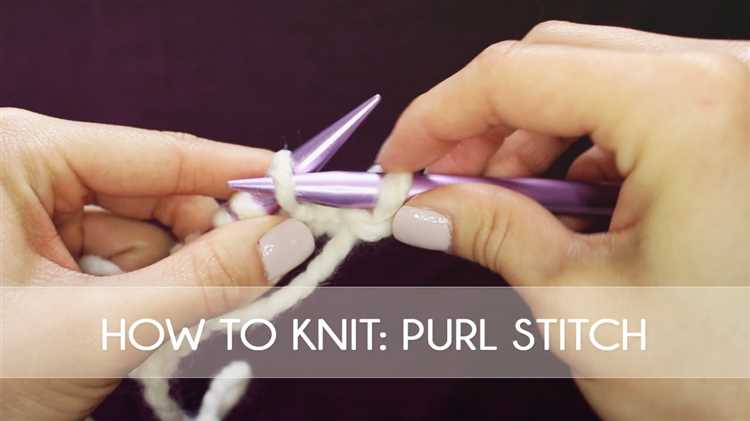Do you want to take your knitting skills to the next level? Learning how to do a purl stitch is an essential technique that will open up countless design possibilities in your projects. Whether you’re a beginner or an experienced knitter looking to expand your skills, this step-by-step guide will help you master the purl stitch with ease.
Understanding the purl stitch is crucial because it creates a different texture and appearance compared to the knit stitch. While the knit stitch is smooth and looks like a “V,” the purl stitch has a bumpy and grainy texture. It’s often used to create patterns such as ribbing, textured stitches, and seed stitch.
To start, you’ll need a pair of knitting needles and yarn of your choice. Hold the knitting needles in a way that feels comfortable for you, with one needle in your right hand and the other in your left. Insert the needle into the first stitch on your left needle as if you’re going to knit.
Pro tip: Keep in mind that the purl stitch is the reverse of the knit stitch. Instead of inserting the needle from left to right, you’ll insert it from right to left.
Once the needle is inserted correctly, wrap the yarn counterclockwise around the right-hand needle. Make sure the yarn is positioned in front of the left-hand needle. Then, bring the right-hand needle through the stitch, from back to front, pulling the yarn along with it.
With the yarn now looped around the right-hand needle, use your right thumb to gently push the stitch off the left needle, leaving the new stitch on the right needle. Congratulations! You’ve just completed a purl stitch! Repeat these steps for each stitch on your left needle until you’ve finished the row.
With practice, the purl stitch will become second nature to you, opening up a world of knitting possibilities. So grab your needles and yarn, and start exploring the beauty of the purl stitch!
Learn how to purl stitch knitting – Easy step-by-step guide
The purl stitch is an essential stitch in knitting, creating a textured pattern and adding versatility to your knitting projects. By mastering the purl stitch, you can create various stitch patterns, such as ribbing, seed stitch, and garter stitch. Here is a step-by-step guide to help you learn how to purl stitch in knitting.
- Hold the knitting needles: Hold the knitting needles in your hand with the working needle in your right hand and the needle with the stitches in your left hand. Make sure the working yarn is hanging off the back of the right needle.
- Insert the right needle: Insert the right needle into the first stitch on the left needle from right to left. The right needle should be behind the left needle.
- Wrap the yarn: Take the working yarn with your right hand and bring it to the front of your work, crossing over the top of the right needle. The yarn should be positioned between the two needles.
- Purl the stitch: Using your right needle, catch the working yarn and pull it through the stitch on the left needle, creating a new stitch on the right needle. Slide the old stitch off the left needle, completing the purl stitch.
- Repeat: Continue to purl stitch across the row, following the same steps for each stitch. Make sure to keep the tension consistent for even stitches.
Learning how to purl stitch opens up a world of knitting possibilities. Practice the purl stitch until you feel comfortable with the technique, and then you can start incorporating it into your knitting projects. With time and practice, you’ll become a purl stitch pro!
Materials needed for purl stitch knitting
To get started with purl stitch knitting, you will need a few basic materials. Here are the essentials:
- Yarn: Choose a yarn that is suitable for the project you have in mind. Make sure it is smooth and easy to work with.
- Knitting needles: Select knitting needles that are appropriate for your chosen yarn. The size of the needles will affect the gauge and tension of your stitches.
- Tapestry needle: This needle is used for weaving in loose ends and sewing seams.
- Scissors: A pair of sharp scissors is necessary for cutting the yarn when needed.
- Stitch markers: These small rings or clips help keep track of stitch patterns and markers to identify the beginning of a round.
- Row counter: A row counter is a helpful tool to keep track of the number of rows worked, especially in more complex patterns.
- Measuring tape: A measuring tape is needed to check the gauge and measure your finished project if necessary.
- Crochet hook: Occasionally, a crochet hook may be required to fix mistakes or create specific stitch patterns.
Having these materials on hand will ensure you are prepared to begin purl stitch knitting and successfully complete your projects.
Step 1: Holding the knitting needles
Before you begin learning how to do a purl stitch in knitting, it’s important to know how to hold the knitting needles properly. Here’s a step-by-step guide:
- Pick the right knitting needles: Choose a pair of knitting needles that are suitable for your yarn weight. Thicker needles are ideal for thicker yarn, while thin needles are better for finer yarn. Make sure the needles are comfortable to hold in your hands.
- Hold the first knitting needle: Hold one knitting needle in your right hand, also known as the working needle. Place it between your index finger and middle finger, resting the tip of the needle on your palm. The pointy end of the needle should extend past your hand.
- Hold the second knitting needle: Hold the other knitting needle in your left hand, also known as the non-working needle. Place it between your thumb and index finger, resting the tip of the needle on your palm. The pointy end of the needle should extend past your hand.
- A comfortable grip: Find a grip that feels comfortable for you. Some knitters prefer to hold the needles with a pencil grip, while others prefer to hold them with a knife grip. Experiment with different grips until you find the one that works best for you.
Once you have a good grip on the knitting needles, you’re ready to move on to the next step: making a purl stitch.
Step 2: Inserting the needle into the stitch
After completing the first step of casting on stitches, you are now ready to insert the needle into the first stitch. This step is crucial as it sets up the foundation for the purl stitch.
Instructions:
- Hold the knitting needle with the cast-on stitches in your right hand. Make sure the tail end of the yarn is hanging down, and the working yarn is coming from the last stitch on your left needle.
- Insert the right needle into the first stitch on the left needle from left to right, going under the left needle.
- Adjust your grip on the needles to hold them firmly but comfortably. Your hands should be relaxed to allow for smooth knitting.
- Hold the working yarn in your right hand and bring it under and over the right needle, forming an “X” shape with the needles.
- Using your right hand, pull the right needle back and through the loop on the left needle. The yarn will wrap around the right needle as you do this.
Note: It’s important to maintain tension on the yarn as you pull it through the stitch, but not too tight to avoid distorting the stitch.
Once you have completed this step, you are now ready to move on to the next step, which is completing the purl stitch. Stay tuned for Step 3!
Step 3: Wrapping the yarn around the needle
Once you have the needle positioned correctly, you are ready to wrap the yarn around the needle to create the purl stitch.
Here’s how:
- Take the working yarn (the yarn attached to your ball of yarn) and hold it in your right hand. Make sure there is enough slack to work with, but not so much that it becomes difficult to handle.
- Bring the working yarn from behind the right-hand needle to the front, crossing over the top of the needle.
- With the right-hand needle, reach over the working yarn and behind the left-hand needle to scoop up the working yarn and bring it through the loop on the left-hand needle, creating a new loop on the right-hand needle.
Repeat these steps for each stitch, making sure to keep the tension of the yarn consistent throughout.
| Step | Description | Image |
|---|---|---|
| Step 1 | Take the working yarn in your right hand. | Image showing the working yarn in the right hand. |
| Step 2 | Bring the working yarn from behind the right-hand needle to the front. | Image showing the working yarn crossed over the needle. |
| Step 3 | Use the right-hand needle to scoop up the working yarn and bring it through the loop on the left-hand needle. | Image showing the new loop on the right-hand needle. |
Continue practicing the purl stitch until you feel comfortable with the motion and rhythm. Remember to take your time and be patient with yourself as you learn this new skill. With practice, you’ll be able to create beautiful and intricate patterns using the purl stitch.
Step 4: Pulling the yarn through
Now that you have completed the purl stitch, it’s time to pull the yarn through to finish the stitch. Follow these steps:
- Insert the right-hand needle into the next stitch on the left-hand needle from right to left, just like you did for the purl stitch.
- With your left hand, hold the yarn behind the needles. The working yarn should be coming from the back of your work.
- Using your right hand, take the yarn and wrap it counterclockwise around the right-hand needle.
- Bring the right-hand needle back to the front of your work, pulling the yarn through the stitch.
It’s important to pull the yarn firmly enough so that the stitch sits snugly against the needle, but not too tight that it becomes difficult to work with.
Continue to repeat these steps for each stitch until you have finished your row or project.
With practice, pulling the yarn through will become second nature and you’ll be able to purl stitch effortlessly.
Step 5: Completing the purl stitch
1. After bringing the working yarn to the front of your work, insert the right-hand needle from right to left through the first stitch on the left-hand needle.
2. Make sure the right-hand needle goes under the left-hand needle to prevent twisting the stitch.
3. With the right-hand needle, wrap the working yarn around the tip of the right-hand needle, moving from right to left.
4. Insert the tip of the right-hand needle back into the stitch on the left-hand needle, from left to right, creating a new loop.
5. Gently pull the right-hand needle through the stitch, bringing the new loop through the old stitch.
6. Slip the old stitch off the left-hand needle, leaving the new loop on the right-hand needle.
7. Repeat steps 1-6 for each stitch until all stitches have been purled.
8. Once all stitches have been purled, you can continue knitting in the purl stitch or switch to a different stitch pattern as desired.
Tips for perfecting your purl stitch knitting
Mastering the purl stitch in knitting is an essential skill for any beginner. Once you have learned how to do a basic knit stitch, the purl stitch opens up a whole new world of patterns and textures. Here are some tips to help you perfect your purl stitch:
- Practice the basic purl stitch: Start by knitting a swatch using only purl stitches. Take your time and focus on maintaining an even tension. The more you practice, the better your purl stitch technique will become.
- Keep an eye on your tension: Tension is crucial when it comes to even purl stitches. Make sure you are not pulling too tightly or too loosely. Experiment with different pressure on the yarn until you find the right balance that creates even stitches.
- Use the correct needle: The needle you use can affect your purl stitch. If you find that your purl stitches are too tight, try using a larger needle. If they are too loose, switch to a smaller needle.
- Watch your stitch orientation: When purling, it’s important to pay attention to the orientation of your stitches. The working yarn should be in front of the needle, and you should insert the needle from right to left through the front of the stitch.
- Take breaks and stretch: Knitting can be hard on the hands and wrists, especially when you are learning a new stitch. Take breaks frequently and do some hand and wrist stretches to avoid strain or injury.
- Experiment with different purl stitch variations: Once you have mastered the basic purl stitch, don’t be afraid to try different variations. There are many purl stitch patterns like seed stitch, ribbing, or basketweave that can create beautiful textures in your knitting.
Remember, practice makes perfect. Don’t get discouraged if your purl stitches don’t look perfect right away. With time and practice, you’ll be able to create beautiful and even purl stitches in your knitting projects.
FAQ:
What is a purl stitch in knitting?
A purl stitch is a basic knitting stitch that creates a raised ridge on the front side of the fabric and a series of loops on the back side. It is the reverse of a knit stitch and is often used to create texture in knitted garments.
How do I do a purl stitch?
To do a purl stitch, insert the right needle into the next stitch on the left needle, from right to left. Wrap the yarn counterclockwise around the right needle, then use the right needle to pull the yarn through the stitch, slipping the old stitch off the left needle. This creates a new stitch on the right needle.


